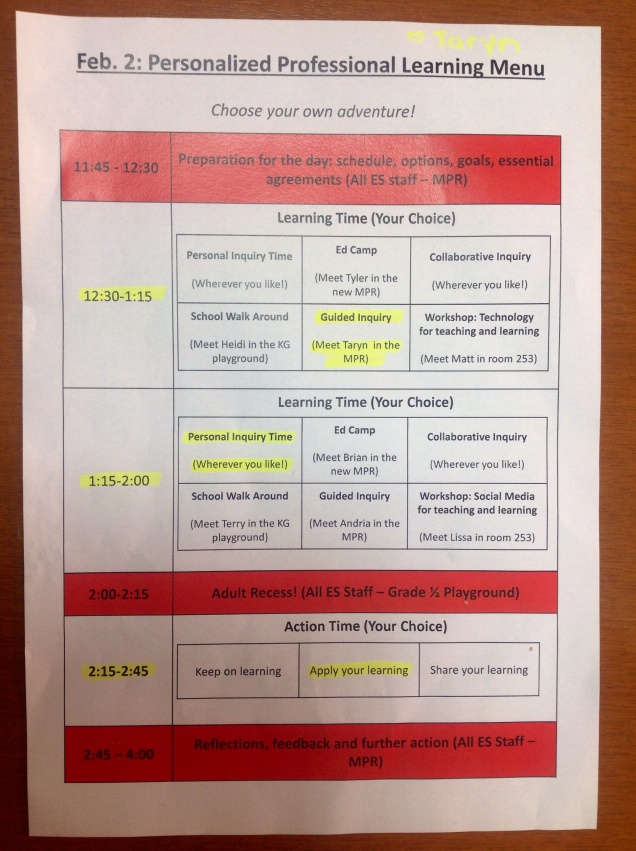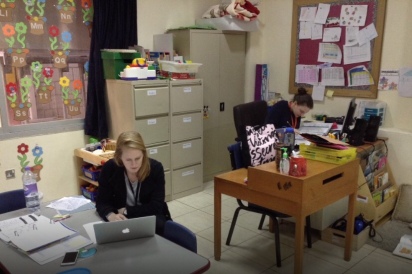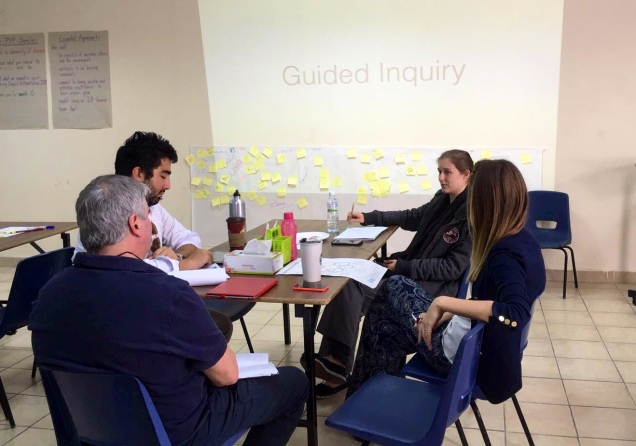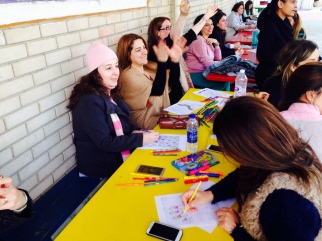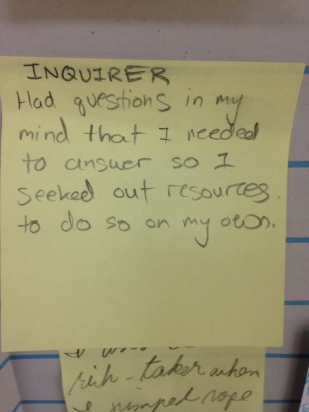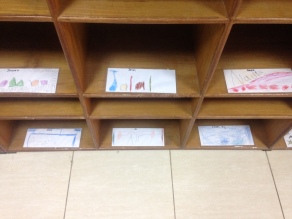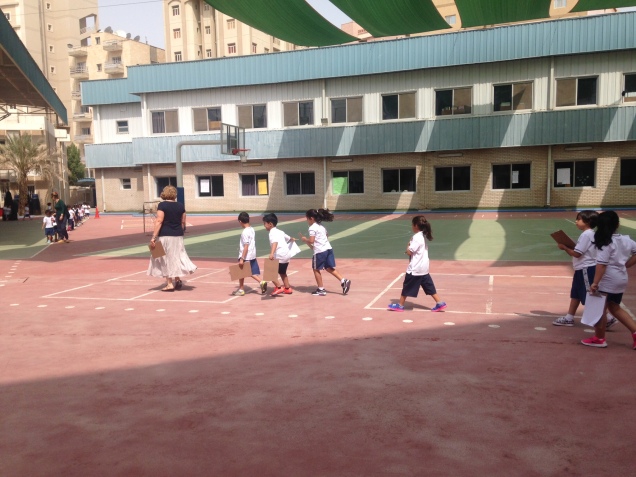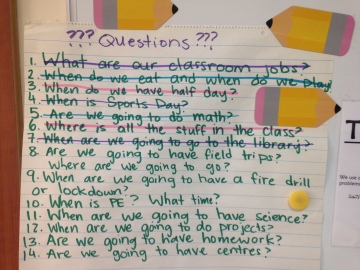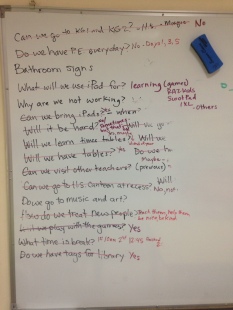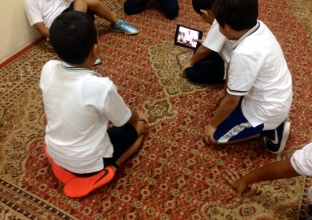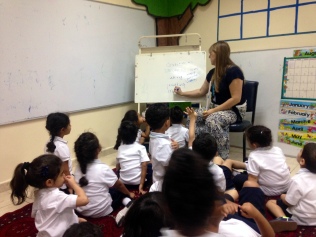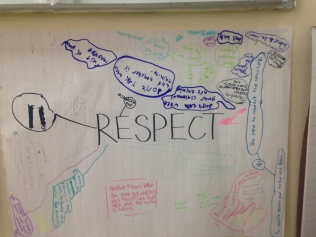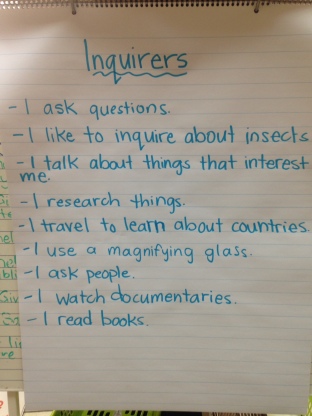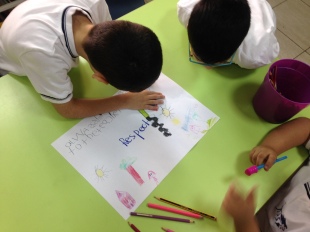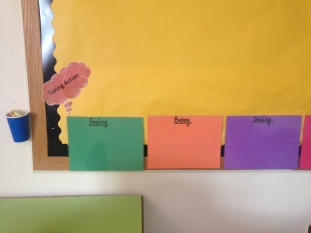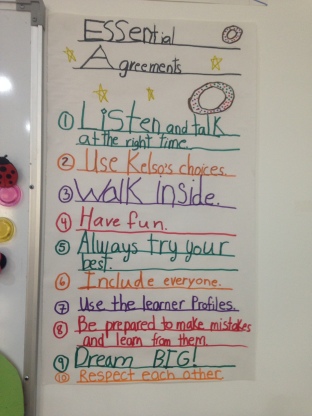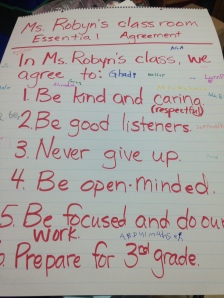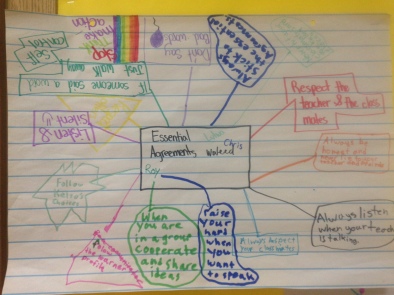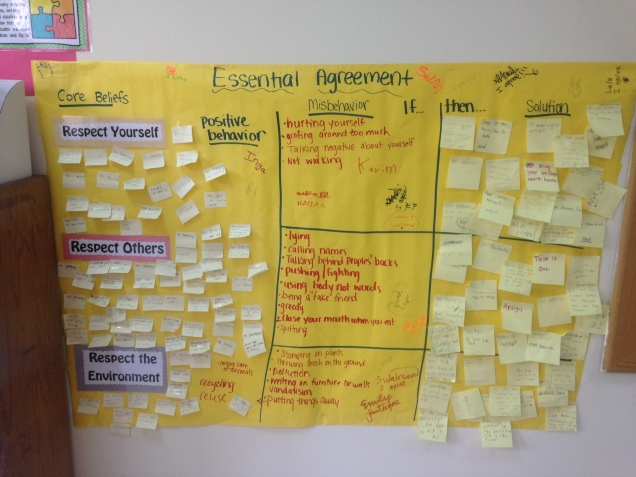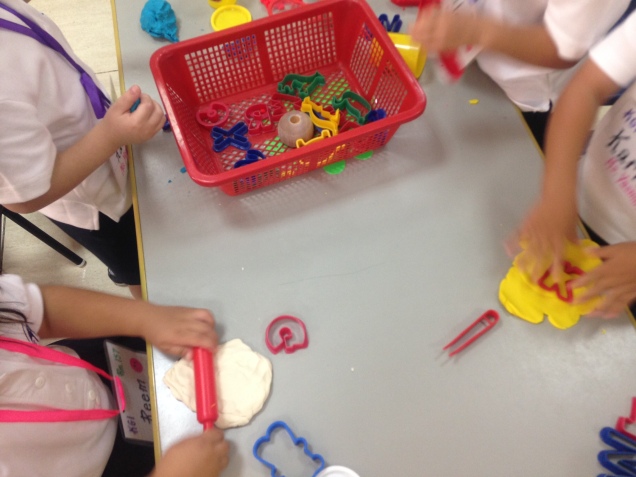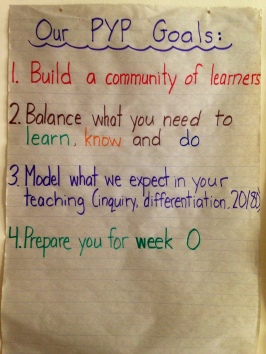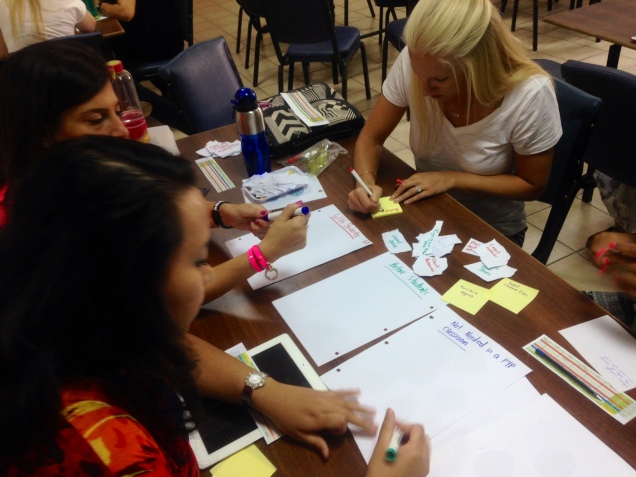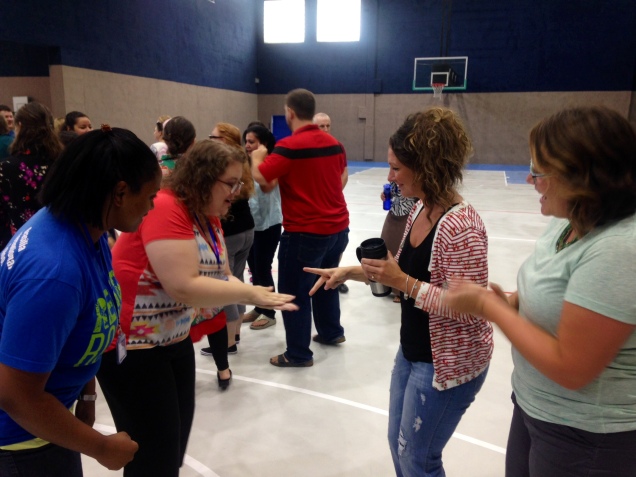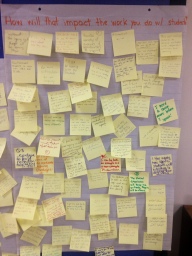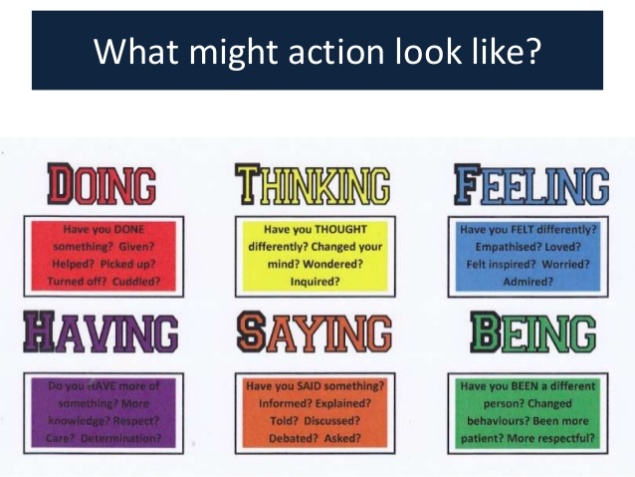Last week I shared our journey towards a half day of personalized professional learning for our Elementary staff. This week it happened… and it was AMAZING!
Here is how it went:
Sunday we sent out an email with some expectations and information for the upcoming half day of professional development learning. The information included a schedule, a reminder to bring a device and a copy of the “learning menu” for the day. We built the menu based on the input we collected the week before from their learning preferences forms.
We also attached brief descriptions for each of the options in the learning and action blocks, as well as options for sharing throughout the day. This gave everyone a few days to think about how they wanted to spend their afternoon of learning.
Tuesday students were dismissed at 11:00 and we were gathered in our multipurpose room ready to go at 11:45.
Connections
We intentionally seated our very large staff in mixed groupings to help build our learning community and allow for some personal connections to be made before we jumped into the learning. We used the chocolate bar activity from this post, where everyone select a chocolate bar or piece of candy that they felt represents them and shared their reasoning with their colleagues at the table. This was a great ice breaker as the room immediately erupted into chatter and laughter!
Today at a glance
Then we took some time to go over the schedule and format of the half day to ensure that we were all on the same page. We also took this time to ensure that everyone’s learning focus for the afternoon was tied together with the common thread of improving student learning.
Options for sharing
Our leadership team felt very strongly that we could trust our staff as professional to drive their own learning and there was no need for an external measure of accountability. We also felt that the true accountability was to one another and the learning community in general, so we wanted to build a variety of ways to allow and encourage everyone to share their learning with each other throughout the day. So we introduced three options for sharing; our shared blog, a back channel using Today’sMeet or through Twitter using our hashtag for the day #AISQ8PPL .
Essential Agreements
We wanted to ensure that all 125 Elementary staff members had a shared understanding of what was needed in order to make this day a truly successful day of learning. We wanted everyone’s voice in this process, so we used a modified ‘growing definition’ structure to help us build our essential agreements. First we had each group of 8 come up with their list of agreements, then we had each group add the one they felt most strongly about to this google doc, which we projected for all to see. After that, we gave an opportunity for the whole staff to review the essential agreements and offer any suggestions or changes they felt were needed. Once all 125 of us were in agreement, we each signed our names.


Learning Block 1 & 2
Each staff member self-selected what they wanted to learn about and how they wanted to learn.
We had staff choose personal inquiry…
Collaborative inquiry…
Guided inquiry…
EdCamp…
School Walkabout…
Workshops…
Sharing throughout the day
It was great to see so many staff members sharing their learning journey throughout the day. We had 3 new posts on our blog, 126 entries on the back channel and 130 tweets on #AISQ8PPL. People were excitedly sharing discoveries, resources, a-ha moments and more!
Adult recess
Then came time for adult recess – which was awesome! All 125 of us headed outside into the fresh air and sunshine to take a little body break and re-charge our minds. We had skipping, colouring, frisbee, soccer, basketball, music, Western dancing, Arab dancing and a lot of laughter.
Action Block
If I’m being totally honest… our action block was much shorter than expected… because we extended adult recess by 10 minutes. (Totally worth it!) But after we managed to pry ourselves away from the fun and the sun, it was awesome to see groups of staff members sitting together sharing their learning, discussing their discoveries and helping one another log on to Twitter. We had 20 new people sign-up for Twitter throughout the course of the day! Talk about learner-initiated action!
Content Reflection
Now it was time to reflect. First, we used the Visible Thinking Routine “I used to think… Now I think” to encourage everyone to reflect on what they had learned and how their understanding of teaching and learning had changed. Staff was invited to either Tweet, back channel or write down their reflection.
Process Reflection
We also wanted everyone to think about how they learned, so we invited everyone to write, back channel or Tweet about how and when they modelled the traits of the IB Learner Profile.
Application Reflection
We also asked everyone to think about their experience as a learner today and how that might impact the work they do with their learners.
Feedback
Finally we asked for some feedback about the afternoon. We set up a google form with two boxes – one for stars and one for wishes. We wanted an honest assessment of how the day went, what worked, what didn’t and suggestions for next time. The responses were overwhelmingly positive! Here is a small representative sample of the 10 pages of feedback we received.
Stars:
- loved the different options for learning
- great to have time to put our learning into action
- nice to have personal choice and freedom
- loved being in charge of my own learning
- adult recess was awesome!!!
- interesting to see what other people were learning
- nice to be trusted to be responsible for my own learning
- differentiated with lots of choice and options
- interacting with people I don’t usually interact with
- range of choices for different learning preferences
- I enjoyed having learning tailored to my needs and interests
- allowed me to reflect on my practice
- relaxed and teacher-centered
- I learned so much!
- the time flew by
- staff were treated as professionals
- great team building and time for collaboration
- appreciated being able to learn at my own pace
- learning options were various and rich
- not having to listen to anyone talk at me
- taking ownership over my learning
- time for exploration, inquiry and reflection
We also received some great constructive feedback that we will use to improve our structure for next time!
Wishes:
- more opportunity for this structure of professional learning
- more time to think about and complete the reflections
- longer sessions to dive deeper into the inquiries
- set up Twitter and social media before the day so we are ready to go
- longer adult recess
- more time to collaborate and share our learning
- a full day instead of only half
- longer time to eat lunch before we start
- bigger variety workshops to choose from, led by teachers
- track the data of what and how everyone is learning
- longer learning blocks
- longer action blocks
How awesome is it that our biggest suggestion from our staff is MORE time for professional learning!?
Thinking back on the day, I have a few of my own personal reflections:
- It was great to develop a structure that allowed for every member of our staff to be a learner and spend time learning things relevant to their position within the school- especially the people who are usually delivering PD on these types of days (admin, coaches, coordinators, etc.)
- It was amazing to see the learner-led action that resulted from this day. Staff members joined Twitter, started blogs, made changes to their teaching practice, signed up for workshops and more
- If you trust your staff and develop the structures to help them to take ownership for their own learning, they will not disappoint. Our staff not only met our expectations, but went above and beyond our hopes and dreams for the day!
- This structure of professional learning did wonders for our sense of community and staff morale
- Sometimes the best way to help someone learn about inquiry, differentiation, learner choice and voice, social media and technology integration is not to have that be the content of learning, but instead the conduit for learning
- Adult recess if life changing
We started on this journey by being very vulnerable and transparent with our staff saying “If you hate PD, that’s a clue to our leadership team that we are doing something wrong.” If that’s true, then hopefully these Tweets and post-its are clues that we’re doing something right…
Since this is the first time we’ve tried something like this, we would love to hear your feedback and suggestions to continue to help us grow and extend our model of personalized, professional learning for all!
